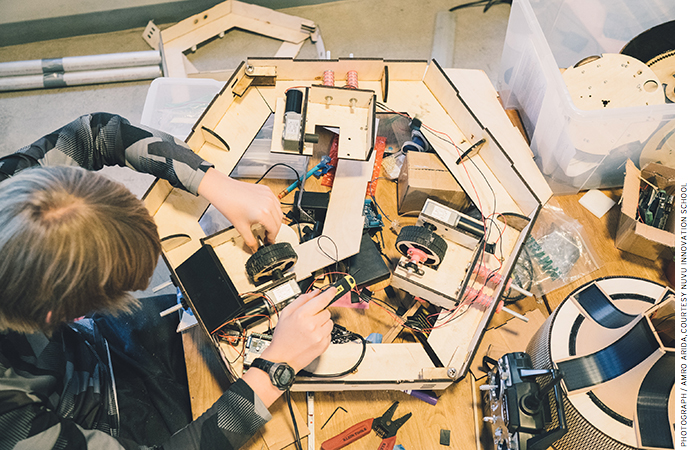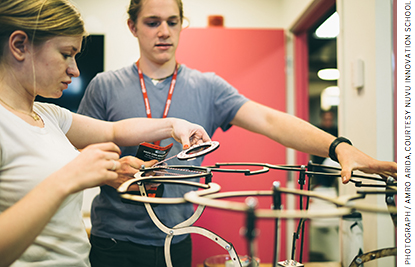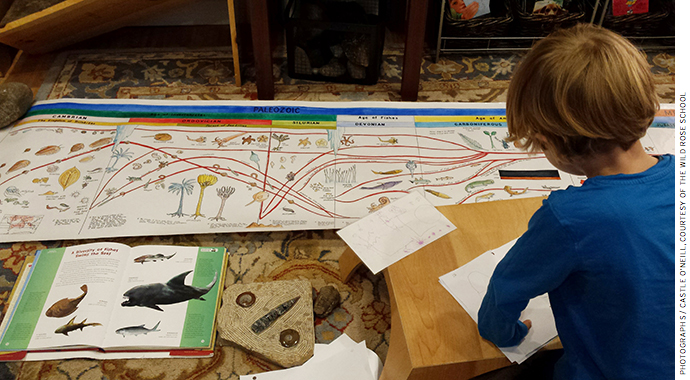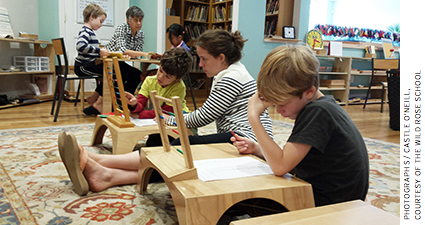
The NuVu Innovation School sits a few blocks west of the Massachusetts Institute of Technology, on the second floor of a steel-and-glass building. Inside an airy open space, small groups of middle- and high-school students spend their days much like the engineers up the street, creating and testing design solutions to everyday problems. Instead of switching between subject-driven classes that teach a common curriculum, they follow a fluid schedule in two-week blocks, and apply math, reading, problem-solving, and other skills to the project at hand. With the help of visiting experts from MIT, they bring their ideas to life on the milling machines and 3-D printers that fill the materials lab.
It may not seem like “school” in the classic sense—but then, that is the point. NuVu is an off-the-grid, independent “micro-school,” whose 60 students are stretching the boundaries of what constitutes education in America. Such boutique programs offer highly personalized environments on a tiny scale, in a tech-enabled reinvention of the one-room schoolhouse that eschews lockstep schedules and standard curricula for student-led learning. They represent a handful of private schools in the country today, but their rapid growth and embrace of sought-after “deeper learning” goals raise important questions about how to scale and democratize the approach.
“There’s a lot about the institutional quality of schools that feels misaligned with our basic humanity,” said Matt Kramer, CEO of the Wildflower Foundation, which supports a network of micro-schools. “Micro-schools provide a school on a more human level. It’s not just the smallness but also the student-centeredness. Both are important, but they’re separate ideas.”
Education futurists have predicted the disintegration of the 19th-century model of American schooling for many years, but the barriers to that transformation have been limited by both the intransigence of the current system and a lack of imagination about what might replace it. Micro-schooling and its teacher-led, entrepreneurial spirit might solve both of these problems, by evading the old habits, sclerotic bureaucracies, cultural biases against experimentation, antiquated labor arrangements, and low tolerance for risk that prevail in traditional schools.
The ground-up genesis of the movement, however, offers as many challenges as it does opportunities. And there is the existential question of whether such small-scale individualized programs should aim to become something other than alternatives on the educational fringe. Then there are the logistics: finding enough experienced educators to manage their own micro-schools, validating the efficacy of the schools’ pedagogy in customized educational environments, and adapting models to accommodate children with a wide range of needs.
But perhaps the most pressing question is whether or not micro-schools and their offshoots can ever serve all children, regardless of their incoming academic skills and ability to pay tuition.
“The micro-school phenomenon is clearly grassroots, but it’s also, with certain exceptions, much more focused at the elite, able-to-pay end of the schooling spectrum,” says Michael Horn, co-founder and distinguished fellow at the Clayton Christensen Institute. “That makes sense from a disruptive innovation perspective, in the sense that you start with the less-complicated use cases before improving the model such that you can reach harder-to-serve students. Whether micro-schools can expand beyond that niche is a huge question.”

A New Tack for Reform
NuVu (pronounced “new view”) may be off the grid, but it’s not alone. It is one of dozens of similarly miniaturized environments across the country; within three miles of NuVu, there are six micro-schools that are part of the Wildflower Montessori network. Similar clusters have emerged in California’s Bay Area, New York City, and Texas. While some micro-schools are rooted in the innovation-driven tech sector, others look more like the fiercely independent mom-and-pop home-schooling collectives that prefaced the programs.
Their defining quality is their size: micro-schools serve numbers of mixed-age students, usually 100 or fewer, often in unorthodox settings. The half-dozen Wildflower Montessori campuses are all housed in storefronts that serve fewer than 30 students. Acton Academy, a relatively established, fast-growing network of micro-schools, enrolls about 100 students at each of its Texas campuses. At AltSchool’s New York City campus, a few dozen students gather in a converted commercial space in downtown Brooklyn. In Denver, Highlands Micro School serves about a dozen students in a cheery suburban house. Families pay tuition that ranges from $3,000 to $30,000 for full-time schooling.

Micro-schools bear some similarities to established alternative private programs such as Sudbury or Waldorf schools; like those programs, student interests and imagination help determine the curriculum. Their one-room-schoolhouse size means that students collaborate outside of normal grade-level structures, often in project-based learning, according to their own pacing and needs. Their teachers typically follow the “guide on the side, not a sage on the stage” model, and assess students for competency and content mastery on an ongoing basis. Some micro-schools have sophisticated technology platforms that provide real-time data on student performance, but enthusiasts emphasize that the technology is an enabler of personalization rather than a goal unto itself.
That kind of personalization offers a clear path to “deeper learning,” by which students actively engage higher-order skills alongside rigorous content. It’s also a goal of policymakers and philanthropists interested in re-fashioning U.S. schools to more adequately prepare graduates for a technologically advanced, collaborative modern workplace. Micro-schools are “the ones that are mutating the most from the standards of the current paradigm,” said Deputy Director Andy Calkins of the Next Generation Learning Challenges (NGLC), which aggregates funds from major philanthropies to make grants that promote innovation and college readiness. “The question now is, what will the system do to incorporate all or some aspects of what these pioneers are creating?”
This idea of bespoke pedagogy challenges some of the central tenets of the last generation of education reform, which relied on standardization as an organizing principle. The innovators in the charter sector, like KIPP and Success Academy, are synonymous with structure. Such standardization facilitated objective accountability, and it is unclear how micro-schools should be held responsible. Most micro-schools reject standardized testing, and almost all serve elementary students. NuVu sent its first graduate to Brown University last year, but the school’s founder, Saeed Arida, admits that his “n size of one” does not constitute actionable data.
An Equity Challenge
Even with pedagogical validation, the current customer profile of micro-schooling creates design constraints. The typical micro-schooling family can afford a private education and is willing to take risks on an unproven design. While this elite etiology is ideal for innovation, the demographic homogeneity of the clientele will make it harder for micro-schooling to address equity. At the Wild Rose School, one of the Wildflower Montessori schools in Cambridge, Massachusetts, only 1 out of its 16 students reads below grade level. Micro-schools do not typically focus on basic literacy and numeracy, which does not bode well for democratizing access, as both scaling and equity require accepting students with a broad range of experiences and incoming abilities.
Bringing this sort of innovative personalized learning to vulnerable communities is a daunting challenge—one that keeps Mieka Wick, executive director of the CityBridge Foundation in Washington, D.C., up at night. CityBridge is one of a group of institutions that received funds from NGLC to pilot personalized learning in at-risk communities. “I want to see the emergence of these models in the communities with the most need,” she said, “but I worry that equity is going to be an afterthought for micro-schooling, if the current innovators continue to develop all of their ideas in the private sector.”
Then there is the question of cost. In order to ensure they have the freedom to innovate, micro-schools are private. While their fees are often lower than other private and parochial schools in their communities, they are not free, unlike charter and public schools, and financial assistance is not widely available, unlike traditional private schools. While some offer part-time enrichment programs, often as a supplement to home-schooling experiences, for the most part, the price of attending a micro-school means they attract financially secure families who are either looking for a bespoke, innovative educational choice for their child or a less-costly alternative to traditional private school.
AltSchool and Acton Academy want to avoid catering to only elite clientele by offering sliding-scale tuition or designing new revenue models, but they don’t yet do either. Wildflower is exploring ways that prospective families might access state child-care assistance programs to cover costs, and one of its schools already relies on that model. Other micro-schools have explored partnerships with traditional public schools, charters, and university sponsors. And policymakers see education savings accounts or vouchers as potential mechanisms for expansion in low-income communities.
Micro-schools do have one important, unexpected boon: they have vaulted to trend status thanks to the attention of important friends. AltSchool, for example, has raised more than $100 million from investors like Facebook founder Mark Zuckerberg and Priscilla Chan. It aims to expand in places that have characteristics hospitable to clusters, such as significant talent density, parents who demand innovation, high concentrations of financial assets to fuel experimentation, and “cultural capital,” an ephemeral influencer effect that can provide a lift in branding micro-schooling as the next big thing.
And, noted Calkins of NGLC, there is pent-up demand for the innovative opportunities they offer. “It wouldn’t surprise me if, 5 to 10 years from now, everyone looks at this and thinks, ‘That grew a whole lot faster than I thought it could,’” he said. “There is a slice of the market that is not being served by public education. They’re saying, ‘The public schools don’t work, [and] I can’t get into the charter schools.’”

Empowering Students—and Teachers
On a Wednesday morning at Wild Rose School, it was time for a dress rehearsal. The writer and producer of the play in question was an eight-year-old boy wearing a T-shirt emblazoned with a drawing of a wolf. His leading lady was in wardrobe, being outfitted with matching wings and a tail.
During the five-minute play, a group of elementary-school-age children reenacted the ancient Greek myth of Bellerophon, who tamed the flying horse Pegasus and slayed the Chimera with a giant leaden spear—or in this case, a large ruler.
“Feedback?” asked the teacher, as rehearsal concluded.
“That’s such a weak roar,” said a critical student to the Chimera.
“You all need to be conscious of facing the audience,” the teacher advised. Turning to the director, she said, “You’re in charge, so you need to decide whether we need another run-through before the performance this afternoon.” While the director considered his next move, the cast dispersed to other activities.
This iterative, student-centered interaction is at the heart of the Wildflower spin on the Montessori model. “The plays are a great way to get them to do a self-directed, complex process,” said Head of School Castle O’Neill, who started the school after a 30-year career as a teacher and administrator. “They come up with an idea, but there’s a set of guidelines. Our plays have to be based on a great work of fiction or nonfiction. The research and script have to be edited and approved by a teacher.”

As is customary for Montessori, the Wild Rose School places heavy emphasis on self-directed learning. As in many Montessori schools, the space is broken into child-sized nooks, the walls alternate between calm, neutral colors, and all of the furniture is made from blond wood. On top of a small bookshelf sits a hamster cage, with a sign indicating that the inhabitant ought to be addressed as “Carl.”
But O’Neill and her peers are also updating the model for the new century. It helps that Sepander Kamvar, a former Google executive who founded Wildflower, launched the network from the MIT Media Lab, which still has a partnership with the schools. When teachers in the network identify an educational need, MIT designers and fabricators work to create new materials in response. For example, on the same day as the dress rehearsal, another group of students worked with a set of elegant wooden tubes designed by the media lab to teach the binary number system used in computer coding. The overall effect was 18th-century schoolhouse meets Apple design studio. “When Maria Montessori died,” O’Neill said, “coding and computational skills weren’t on people’s radar yet, but these are the skills that kids need in the world now.”
The school’s flexible, responsive model is critical for teachers, too. Micro-schools offer a unique opportunity for teacher leadership, said Wildflower Foundation leader Kramer, the former co-CEO of Teach For America. He is bullish on using the schools to reinvigorate a profession that feels under constant assault. “We’ve seen a 30-year decline in teacher satisfaction to an epically low level,” he said. “Micro-schools offer a creative new way of thinking about teachers acting like social entrepreneurs.”
Having more teachers like O’Neill leading schools is critical if micro-schools will ever be more than a niche endeavor. She moved from Seattle to start the school, because she wanted the opportunity to lead a school as an administrator. Such leadership feels impossible in a larger system, where teachers have standoffs with administrators over picayune issues. Working outside of such systems, however, brings its own challenges, such as handling the administrative tasks that centralized districts take on for school leaders, like insurance, purchasing, and web development.
And leading any school takes not only expertise but experience. “The challenge of the Wildflower model is that we can’t have first-year teachers doing this,” said O’Neill.
Still, she and Kramer see a big future for their model. “We hear from about one person a day that wants to start a Wildflower school,” Kramer says. “Our expansion will not be driven by growth goals, but rather [will be] organic, in the sense that the schools are created and led by teachers.”
Can Bespoke Get Big?
But can micro-schools grow while remaining, well, “micro”? Observers are divided on whether the model can scale and democratize while retaining its definitional qualities.
One possible way forward is through partnerships with local school districts, such as Powderhouse Studios in Somerville, Massachusetts, 1 of 10 recent winners of the XQ: The Super School Project, the $10 million high-school redesign competition founded by Laurene Powell Jobs (see “Will the XQ “Super Schools” Live Up to Their Name?” features, Spring 2017). Powderhouse is atypical in some aspects: it will report to the local school district, and students will take statewide standardized tests. But its planned program resembles other micro-schools, not the rest of the district, with student-centered project-based learning at its core.
Powderhouse Studios founder Alec Resnick is skeptical of rapid scale, but he thinks that growth and customization are compatible. “You can see the national networks looking like movie studios,” he says, “where they’re basically fronting the capital to educators for expansion. That’s different than operating schools from the top down.”
Another model partners a micro-school with private schools. NuVu, for example, grew out of a partnership with a local private school seeking enrichment opportunities for accelerated students, which now sends 20 of its students to NuVu each term. Other private and charter schools also send their students for full-time study at NuVu as part of their programs.
Establishing such partnerships, however, takes time. “We told our potential partners that the only way we can work with you is to have a slot in the schedule, no matter how small it is, to allow us to do whatever we want, without any subject standards,” said NuVu founder Arida. “It took three years to get a single partner, and we have 80 minutes every other day in that school, which is private.”
Unwinding these contradictions may be impossible, but balancing individualization with the greater good is a constant tension, in both schooling and public life. “When there isn’t a community newspaper that everybody’s reading, what knits everybody together?” said NGLC’s Calkins. “The same idea applies here. What happens when everybody is pursuing their own very personalized pathway, in their own micro-schools, driven in part by their own interests?”
Wildflower’s Kramer is sympathetic but believes that the benefits outweigh the liabilities. “If you think about what modern neuroscience research tells us, the basic principle of learning theory is that kids learn more when they get to follow their interests,” he said. “What we need are human-scaled, autonomous school environments. Micro-schools are not a magic solution, but they do work on important topics that we haven’t figured out at scale anywhere else.”
Justin C. Cohen is a fellow at the Broad Center for the Management of School Systems, and former president of Mass Insight Education and senior adviser at the District of Columbia Public Schools.
This article appeared in the Spring 2017 issue of Education Next. Suggested citation format:
Cohen, J.C. (2017). School Disruption on the Small Scale: Can micro-schools break out of an elite niche? Education Next, 17(2), 28-33.


